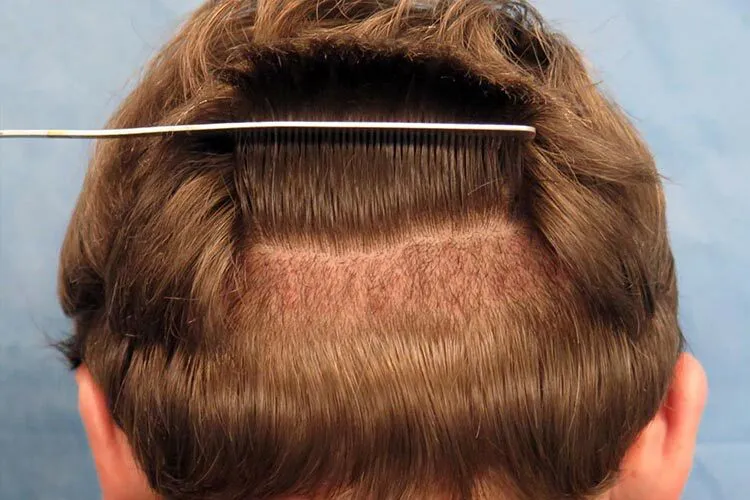
Do you have questions? Let us answer now!
Leave your number and we will call you shortly, answer any question you’d like to ask.
Definitive Hair Transplantation Guide
Hair transplantation is the transplantation of head or body hair in patients with severe, irreversible hair loss. As a rule, the follicles (hair roots) are taken from the hair ring at the back of the head, but the beard, chest, calf, or other hair can also be used for hair implants, depending on the condition. These are then transplanted into bald or thinned areas.
Hair Transplantation or Replacement
Full hair has always been a sign of youth, health, and vitality. It is therefore psychologically very stressful for many people when their hair becomes thinner with age. When looking for a remedy, those affected are faced with a huge selection of products or treatments, like mesotherapy, that promise to help against hair loss. Very few are scientifically proven – and the active ingredients usually have to be used for a lifetime for successful treatment. With the help of a hair replacement, convincing results can be achieved in many patients without many years of treatment.
Hair transplant for women in Turkey and hair replacement for men in Turkey are surgical procedures in which healthy hair is transplanted into bald areas. By precisely planning the redistribution, the doctor can cover bald areas so that they are no longer visible afterward. However, a hair transplant is not suitable for every patient. How satisfactory hair transplant results depend, among other things, on the extent of the hair loss, the condition of the remaining hair, and finding the best hair transplant clinic in Turkey. The next step is to find the best hair transplant doctors in Istanbul. You can fill out the form at the top of the page to find the best hair transplant doctors in Istanbul / Turkey.
Our Services

Flight to Istanbul
When your flight arrives, Vanity transfer will meet you at the exit of arrival with Vanity showcard to take you to the hospital for controls.

Doctor Consultation
Vanity transfer will take you to the hospital to have your last consultation with the doctor. Your doctor will check your hair density in the donor area(s) and determine the number of grafts needed for the transplant.

Operation
We are performing FUE and DHI methods under local anesthesia. It is safe and painless process. During the hair transplant operation in Istanbul, you could watch TV or listen music.
Types of Hair Loss
The most common form of hair loss in men and women is androgenetic hair loss (androgenetic alopecia). A hair transplant is usually a good solution for people with this form of hair loss. In androgenetic hair loss, some of the hair roots are overly sensitive to the hormone dihydrotestosterone (DHT). This shortens the growth phase and shrinks the affected hair follicles. Especially thinning of the hairline is observed, which is treated with hairline surgery
However, since only part of the hair roots develop this androgen sensitivity, healthy hair can be taken from the remaining areas and transplanted to the bald areas. When androgenetic alopecia occurs and what form it takes (receding hairline, diffuse hair loss, semi-baldness) depends on the patient’s genetic predisposition.
With other forms of hair loss, hair transplantation is not always promising. If the hair loss is hormonal or caused by certain diseases, the transplanted hair could also fall out. For a successful treatment, the hair loss should have been brought to a standstill (e.g. with medication) and there must be enough healthy hair available for the transplantation. It is therefore important to precisely determine the cause(s) of the hair loss.
The following types of hair loss are suitable for a hair transplant in Istanbul:
- Men: Androgenetic alopecia
- Women: Androgenetic or hormonal alopecia
- Hereditary forms of alopecia / hypotrichosis
- Scarred alopecia (caused by accidents, burns, surgeries, inflammation)
Who Can Have a Hair Transplant?
Hair transplantation is basically suitable for every patient who has a sufficient number of healthy donor hairs. The donor hair should be relatively thick and strong so that a satisfactory result can be achieved and hair transplant side effects reduced. For patients with very little residual hair or very thin hair, this procedure is only of limited use. Depending on the condition of the hair, eyelashes, beard, back, chest, or beard hair can also be transplanted.

VIP Transfer
During your stay in Turkey, we provide all your transportation between the airport, hotel and hospital with VIP vehicles.

Hotel
We have agreement with luxury hotels (Mercure Altunizade, Ramada Altunizade, Hilton Umraniye) so according to your choice we will arrange your accommodation and provide transfer.

Hospital
After your arrival, our transfer vehicle takes you to the Vanity Cosmetic Surgery Hospital and start the operation process with your doctor.
Types of Hair Transplantation
There are basically 2 methods for removing the transplants: the FUT hair transplant (Follicular Unit Transplantation) and the FUE hair transplant (Follicular Unit Extraction). Which one is used depends on the patient.
In the FUT method, the doctor uses a scalpel to remove healthy hair roots from an entire strip of skin. Here, it is important to choose an area that is not affected by hair loss, this usually applies to the back of the head. Tiny groups of hair roots are then cut out of the removed strip of skin and prepared for transplantation. A scar remains at the cutting point, which can be covered with the surrounding hair. This method of removal is therefore more suitable for people with long hair.
With the FUE method, the removal takes place directly in the form of individual hair transplant holes. Fine hollow needles or hollow drills are used for this. The “grafts” obtained in this way comprise up to 5 hairs and can be transplanted without further subdivision. The main advantage over the FUT method is that there is no visible scar. However, the hair in the donor area must be shortened to a few millimeters in order to obtain the transplants. This option is therefore more suitable for people with short hair.
Before Having Hair Transplant Surgery
Before the hair transplant in Turkey, the doctor provides detailed information about the chances and risks of hair transplant infection. In particular, they warn the patient against unrealistic expectations. As part of the preliminary talk, the doctor also inquires about previous illnesses that could limit the suitability for the operation. This applies, for example, to patients with a blood clotting disorder or a tendency to excessive scarring.
The donor area and the future hairline are precisely planned by the surgeon to ensure a natural-looking result. The patient should let their hair grow as long as possible until the day of the operation. In this way, the treated areas can be covered with the surrounding hair after the procedure until full hair growth begins.
Hair transplantation is basically a procedure with few complications and a good chance of success. The best hair transplant requires careful planning and preparation. Turkish hair transplant is considered the best, performed by experienced surgeons. There are many images of hair transplant before and after that show Turkey’s hair transplant clinic success.
Hair Transplantation Process in Turkey
Hair transplantation operation takes couple of hours depending on the technique used by the doctor and the patient’s condition. Below are the common steps in the hair operation.
DHI Method
DHI Hair Transplantation can be expressed as taking hair individually. In this technique, donor grafts are transferred one by one without incision, collecting grafts collectively.
Anesthesia
We use local anesthesia or sedation for the area of hair transplantation and prepare you for a painless operation.
Comfortable Process
You can continue your social life on the same day after the hair transplant operation in Turkey. It is very important to follow the advice of your doctor so that recovery does not slow down after the operation. To prevent complications, your doctor may prescribe painkillers or antibiotics.
After Hair Transplant
Before the hair transplant, the doctor provides detailed information about the chances and risks of hair transplant infection. In particular, they warn the patient against unrealistic expectations. As part of the preliminary talk, the doctor also inquires about previous illnesses that could limit the suitability for the operation. This applies, for example, to patients with a blood clotting disorder or a tendency to excessive scarring.
Hair Wash
We call you again to wash your hair 1-2 days after the operation. So we keep you informed about how to care for your hair while you follow the process.
Back to Work
vMost patients feel ready to return to work or school after 1 or 2 days, depending on the level of activity needed.
Results
vMost patients feel ready to return to work or school after 1 or 2 days, depending on the level of activity needed.
Frequently Asked Questions About Hair Transplantation
How does hair transplant work?
It works through removing the hair individually (FUE method) or via a strip of tissue at the back of the head (FUT method) and re-implanted. In hair transplantation, doctors transplant hair roots from denser areas to balder areas to replace lost hair.
What is a hair transplant?
It is a procedure that involves groups of individual hairs being removed from the back of the head, which is usually overgrown. These follicular units are also known as grafts. These grafts are then replanted in bald spots. The aim is permanent, strong hair growth in the hair loss region.
How hair transplant is done?
The obtained hair root groups are stored in a cooled nutrient solution until the next step. The doctors make openings either with a micro drill (holes technique) or with a tiny knife (slit technique). They determine the density and the subsequent direction of hair growth. A practiced surgical team can transplant 1000 to 1500 groups of hair roots in one session. A session usually lasts between three and six hours.
How long hair transplant last?
The successfully transplanted hair will not fall out for a lifetime. Even after the transplant, you remain immune to the hormones that trigger hereditary hair loss.
How many hair transplant grafts do I need?
For example, if the bald spot is 50 square centimeters, depending on the color and structure of the hair, 500 to 1250 transplanted hair root groups are needed – the result from ten hair root groups per square centimeter is usually visually satisfactory, from 25 hair root groups per square centimeter very good. Larger bald spots may require two to three sessions.
Which hair transplant method is best in Turkey?
There are a variety of different methods that are tailored to your individual situation. You should discuss which method of hair transplantation is best for you with your doctor in a personal meeting.
Why hair transplant fail?
In general, a hair transplant is a low-risk treatment that promises good results. Since transplants are endogenous material, rejection is not expected. If a transplant fails, it is most likely due to poor operation or unhealthy transplants.
How many days after hair transplant can I sleep normally?
As long as you are gentle, you can sleep normally. You can wash, cut, blow-dry, and dye the transplanted hair just like your own hair.

